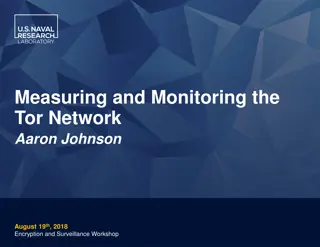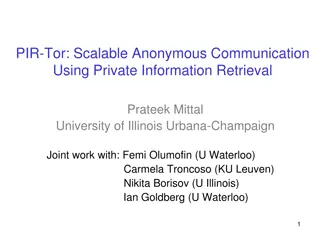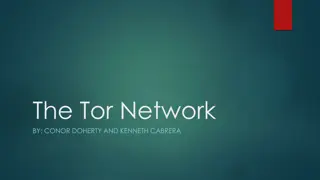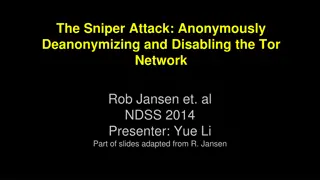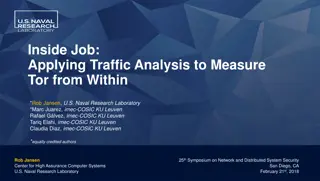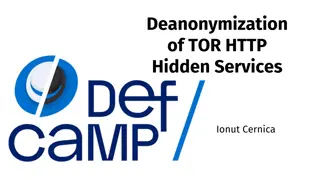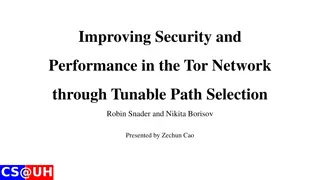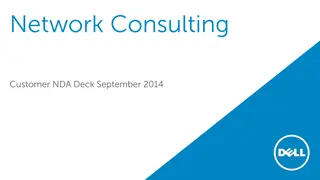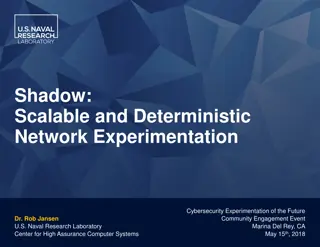Apache MINA: High-performance Network Applications Framework
Apache MINA is a robust framework for building high-performance network applications. With features like non-blocking I/O, event-driven architecture, and enhanced scalability, MINA provides a reliable platform for developing multipurpose infrastructure and networked applications. Its strengths lie i
3 views • 13 slides
Modeling and Generation of Realistic Network Activity Using Non-Negative Matrix Factorization
The GHOST project focuses on the challenges of modeling, analyzing, and generating patterns of network activity. By utilizing Non-Negative Matrix Factorization (NMF), realistic network activity patterns can be created and injected into live wireless networks. Understanding and predicting user behavi
4 views • 28 slides
Automated Anomaly Detection Tool for Network Performance Optimization
Anomaly Detection Tool (ADT) aims to automate the detection of network degradation in a mobile communications network, reducing the time and effort required significantly. By utilizing statistical and machine learning models, ADT can generate anomaly reports efficiently across a large circle network
8 views • 7 slides
Revolutionizing Network Management with Intent-Based Networking
Explore the concept and benefits of Intent-Based Networking (IBN) in simplifying network configuration and enhancing efficiency. Learn how IBN automates network operations, aligns with business objectives, improves security, and ensures scalability and reliability. Discover the potential of IBN tool
0 views • 14 slides
Network Compression Techniques: Overview and Practical Issues
Various network compression techniques such as network pruning, knowledge distillation, and parameter quantization are discussed in this content. The importance of pruning redundant weights and neurons in over-parameterized networks is highlighted. Practical issues like weight pruning and neuron pru
0 views • 37 slides
Network Slicing with OAI 5G CN Workshop Overview
Overview of Network Slicing with OAI 5G CN workshop focusing on the crucial role of network slicing in realizing the service-oriented 5G vision. This workshop covers topics like multiple logical networks creation on shared infrastructure, different types of network slices, preparation and instantiat
1 views • 6 slides
Network Design Challenges and Solutions in Business Data Communications
Issues in designing a Local Area Network (LAN) include needs analysis, technological design, and cost assessment. The traditional approach involves structured systems analysis, but faces challenges due to rapidly changing technology and increasing network traffic. The Building Blocks Approach recomm
1 views • 20 slides
Measuring and Monitoring the Tor Network: Privacy Risks and Transparency Challenges
This content delves into the complexities of measuring and monitoring the Tor network, highlighting the inherent privacy risks and transparency challenges involved. It discusses issues such as deanonymization, storing sensitive data at relays, and the potential for leaks and compromises. The importa
6 views • 25 slides
Understanding 5G RAN Network Slicing and Architecture
Explore the intricate world of 5G Radio Access Network (RAN) and Network Slicing, delving into concepts such as SO Service Orchestrator, SDN-C Service Design, and Core Network Elements. Discover the significance of managing and designing mobile slice services, including eMBB, Massive IoT, and Missio
0 views • 26 slides
Understanding Snort: An Open-Source Network Intrusion Detection System
Snort is an open-source Network Intrusion Detection System (NIDS) developed by Cisco, capable of analyzing network packets to identify suspicious activities. It can function as a packet sniffer, packet logger, or a full-fledged intrusion prevention system. By monitoring and matching network activity
0 views • 23 slides
Data Flows and Network Challenges in Particle Physics Infrastructure
This overview delves into the data flows and network challenges faced in particle physics infrastructure, focusing on the JUNO project. It discusses the process of data reception, storage, and replication across various data centers, highlighting the bidirectional nature of data flows. Additionally,
0 views • 24 slides
Evaluating Website Fingerprinting Attacks on Tor
This research evaluates website fingerprinting attacks on the Tor network in the real world. It discusses the methodology of deanonymizing Tor users through predicting visited websites, emphasizing the need for labels to train machine learning classifiers. The study presents a threat model involving
0 views • 26 slides
Progress of Network Architecture Work in FG IMT-2020
In the Network Architecture Group led by Namseok Ko, significant progress has been made in defining the IMT-2020 architecture. The work has involved gap analysis, draft recommendations, and setting framework and requirements. Phase 1 focused on identifying 19 architectural gaps, such as demands for
1 views • 11 slides
Understanding Interconnection Networks Topology
Exploring the topology of interconnection networks helps determine the arrangement of channels and nodes, impacting network cost, performance, latency, energy consumption, and complexity of implementation. Abstract metrics such as degree, hop count, and network diameter play crucial roles in evaluat
1 views • 56 slides
Transportation Network Modeling and Analysis with C.Coupled SE Platform
This content outlines the features and functionalities of the C.Coupled SE Platform (CSET Platform) developed by the Connetics Transportation Group. It covers aspects such as interface design, inputs merging, purposes, platform development using Cube, TAZs merging, and network attributes. The platfo
0 views • 11 slides
Human Disease Symptom Network: Understanding Disease Relationships Through Symptoms and Genes
The Human Disease Symptom Network (HSDN) is constructed using a large-scale medical bibliographic records database to form a network of human diseases based on symptom similarities. By integrating disease-gene associations and protein-protein interaction data, correlations between symptom similarity
0 views • 37 slides
Introduction to Network Analysis Using .NET
This presentation introduces the concept of network analysis using .NET in the humanities classroom. It provides a template for teaching and adapting network analysis tools for educational purposes. The guide explains the relevance of networks in processing and visualizing data, emphasizing the coll
0 views • 20 slides
Investigating Computational Intelligence: Reading What Machines Think at University of Rome Tor Vergata
Researchers at University of Rome Tor Vergata are delving into the intriguing realm of understanding and predicting human brain activity by observing cognitive tasks using computational machines. Their motivation lies in bridging the complexity of computers with the mysteries of the human brain, aim
0 views • 20 slides
TORKARI: High Strength Reinforcing Steel Innovation by Torsteel Group
TORKARI is a high-grade steel reinforcing bar introduced in India in 1987 by TRFI, offering superior strength and bond properties conforming to Fe550 Grade (Tor-55). Manufactured using Baustahlgewebe technology, it outperforms traditional Torsteel with smaller diameters while being cost-effective. P
0 views • 56 slides
Meridian: An SDN Platform for Cloud Network Services
Meridian is an SDN platform developed by Mohammad Banikazemi, David Olshefski, Anees Shaikh, John Tracey, and GuohuiWang at IBM T. J. Watson Research Center. The platform focuses on providing cloud network services efficiently. It encompasses an architecture that enables faster and more convenient n
0 views • 21 slides
PIR-Tor: Scalable Anonymous Communication Using Private Information Retrieval
Anonymous communication via PIR-Tor allows users to communicate while keeping their identities secret from third parties. This research discusses the background of Tor, performance issues in its architecture, current solutions, design goals for improvement, and key observations for enhancing relay s
0 views • 16 slides
Understanding the Tor Network: An In-Depth Overview
The Tor Network, developed in the mid-1990s, is a volunteer-based network that prioritizes privacy and security for Internet users through encryption and random pathways. By utilizing Onion Routing, Tor preserves anonymity but has limitations such as lack of application-level security and plugin usa
0 views • 13 slides
Enhancing Network Security with Software-Defined Snort and OpenFlow
Explore the implementation of Snort, Barnyard, and PulledPork within a Software-Defined Network framework using OpenFlow technology. Learn how these tools enhance network security through intrusion detection engines, rule management, and network traffic control mechanisms. Dive into the architecture
0 views • 15 slides
Understanding Network Metrics Through Centrality Analysis
This presentation introduces network metrics as tools to describe network characteristics and answer important questions. Using centrality metrics as an example, participants learn how to identify the most important nodes in a network based on different criteria such as degree centrality and closene
0 views • 15 slides
Understanding the Sniper Attack on Tor Network
Explore the implications of the Sniper attack, which aims to anonymously deanonymize and disable the Tor network. Learn about defense strategies against this threat and delve into the background of large-scale internet censorship that drives the development of privacy-enhancing tools like Tor.
0 views • 54 slides
Traffic Analysis for Measuring Tor from Within
Study by Rob Jansen and team explores traffic analysis techniques to measure Tor from within the network, focusing on website and onion service fingerprinting. The research examines the limitations of entry positions and advantages of middle relays in fingerprinting attacks on Tor. By considering ad
0 views • 25 slides
Deanonymization of TOR HTTP Hidden Services - Techniques and Defense
This detailed content delves into the deanonymization of TOR HTTP hidden services, discussing known techniques, downgrading the protocol, and potential fixes. It covers the concept of hidden services, key certificate risks, search methods, and Gzip compression vulnerabilities. The author, a security
0 views • 32 slides
Understanding Network Analysis: Whole Networks vs. Ego Networks
Explore the differences between Whole Networks and Ego Networks in social network analysis. Whole Networks provide comprehensive information about all nodes and links, enabling the computation of network-level statistics. On the other hand, Ego Networks focus on a sample of nodes, limiting the abili
0 views • 31 slides
Understanding Network Interference in CS590B/690B Lecture
Delve into the realm of network interference through the CS590B/690B lecture with Phillipa Gill at UMass Amherst. Explore topics such as Internet routing, timing attacks, BGP hijacks, Tor network functionality, relay selection, collusion scenarios, use of guards, web site fingerprinting attacks, tra
0 views • 11 slides
Contribution of HALA Network to ATM Community and SESAR 2020: Achievements and Future Directions
HALA network has been instrumental in fostering research and innovation in the field of automation for ATM systems, providing a platform for knowledge dissemination, collaboration, and advancement. The network has facilitated exploratory research, encouraged young scientists' participation, and crea
0 views • 12 slides
Accuracy of Tor Bandwidth Estimation Study
Study by Rob Jansen and Aaron Johnson from the U.S. Naval Research Laboratory reveals that Tor underestimates its network bandwidth capacity, with significant errors in estimation for high-capacity relays, exit relays, and relays with lower uptimes. The findings emphasize the importance of accurate
0 views • 16 slides
Enhancing Tor Network Security and Performance with Tunable Path Selection
This presentation discusses the improvement of security and performance within the Tor network through tunable path selection. It covers Tor's design, proposed methods for bandwidth measurement, router selection algorithms, and the evaluation of different strategies to enhance the network's efficien
0 views • 29 slides
Exploring Network Slicing in Future 5G Networks
The research delves into the design of a 5G-ready architecture known as NFV-based Network Store, aiming to serve as a digital distribution platform for 5G applications. By focusing on network slicing and programmability, the architecture enhances resource efficiency and agility in deploying software
0 views • 17 slides
Network Function Virtualization (NFV) Overview
Network Function Virtualization (NFV) focuses on virtualizing network functions to improve efficiency and reduce costs in network infrastructure. The lecture discusses key readings, devices that compose a network, specialization of devices, benefits of one-device-does-anything approach, and the goal
0 views • 21 slides
Enhancing Network Stability with Network Monitoring Systems
Network monitoring is crucial for efficient management and proactive issue detection in a network environment. Factors influencing an effective network system include choosing the best OEM, SLA agreements, and selecting a reliable System Integrator. Reactive monitoring can lead to financial losses a
0 views • 12 slides
Dell Network Consulting Services Overview
Dell Network Consulting provides expert insights and workshops to enhance your network infrastructure's efficiency. Services include network assessments, topology discovery, traffic analysis, and wireless site assessments. Deliverables include detailed reports, remediation plans, and infrastructure
1 views • 5 slides
TOR Athletic Dynamite Long Bodysuit - High-Performance Activewear for Ultimate C
The TOR Athletic Dynamite Long Bodysuit is designed for peak performance, combining style, comfort, and flexibility. Crafted from premium, breathable fabric, it provides a smooth, second-skin fit that moves with you during intense workouts or daily a
1 views • 6 slides
Shadow: Scalable and Deterministic Network Experimentation in Cybersecurity
The presentation discusses the concept of deterministic experimentation in cybersecurity, emphasizing the importance of experimental control and scalability in large distributed systems like Tor. It introduces Shadow, a network simulator designed to achieve repeatable and realistic experiments for r
0 views • 15 slides
Accelerating Systemic Change Network Inaugural Workshop Summary
The Accelerating Systemic Change Network held its inaugural workshop at Howard Hughes Medical Institute in July 2016 to address the lack of coordination in improving higher education. With a vision to become a professional hub for change researchers in STEM education, the network aims to enhance ind
0 views • 5 slides
University Network Section Overview July 2015 - March 2016
The presentation covers the network team structure, team members, objectives, goals, report outline, network statistics, accomplishments, and future plans of the university network section from July 2015 to March 2016. It highlights efforts to provide stable internet and intranet services, restructu
0 views • 16 slides







